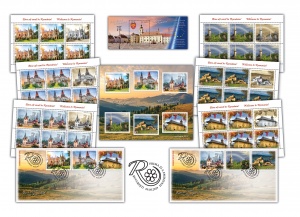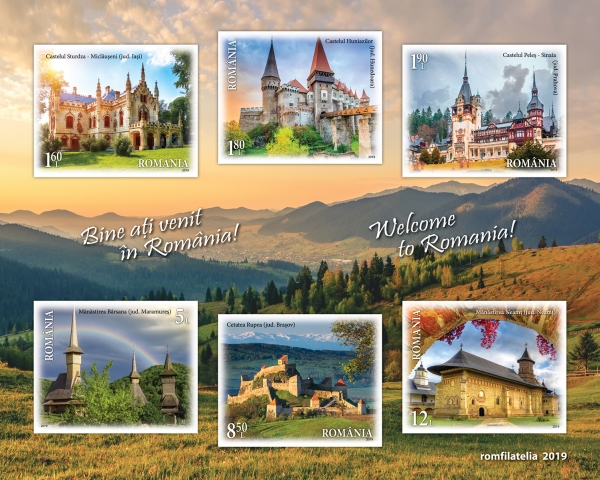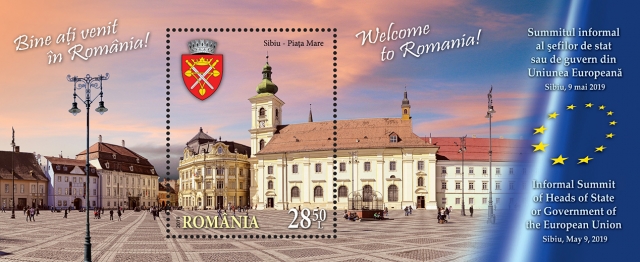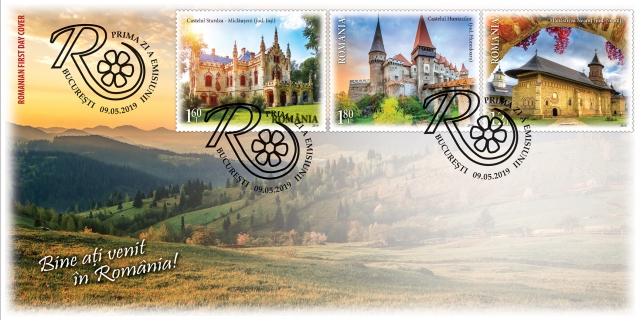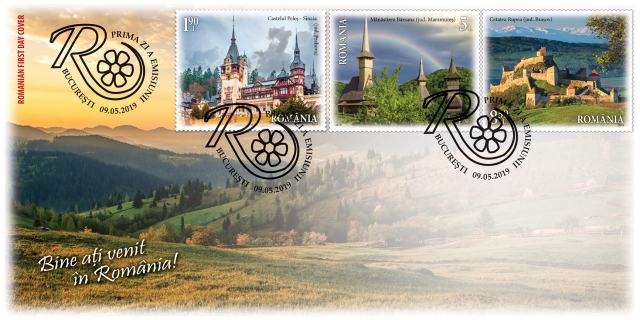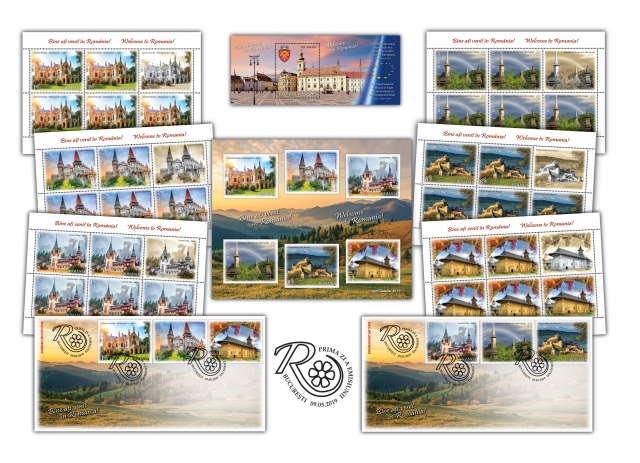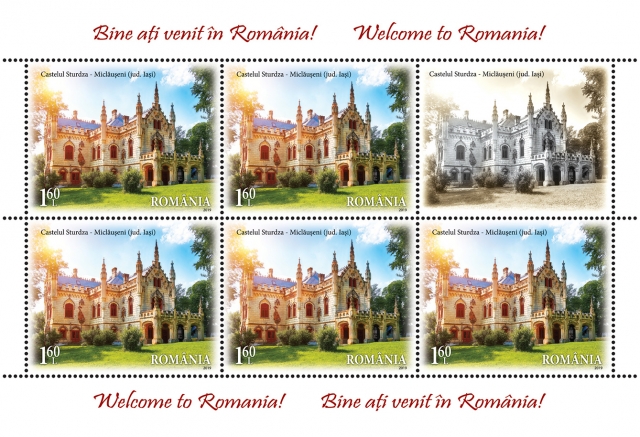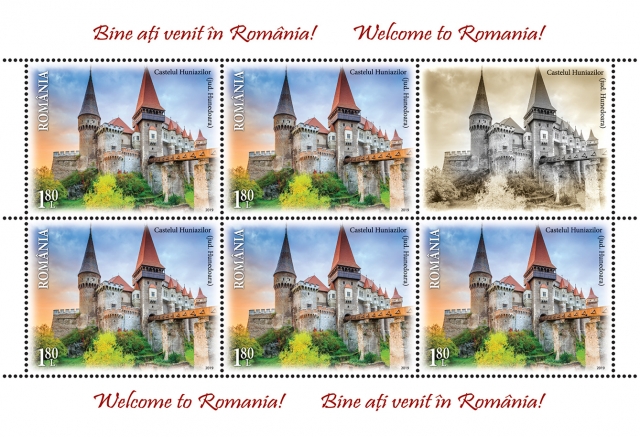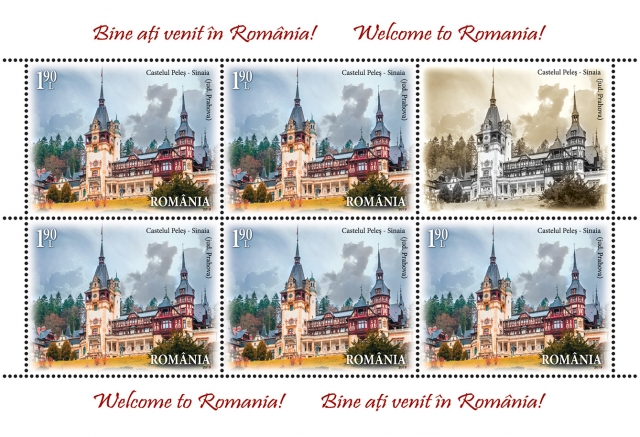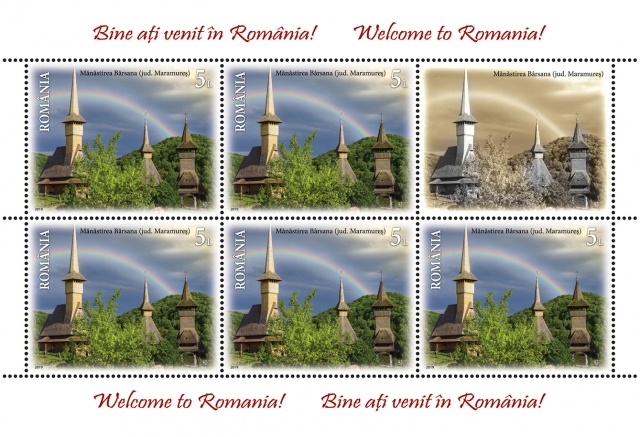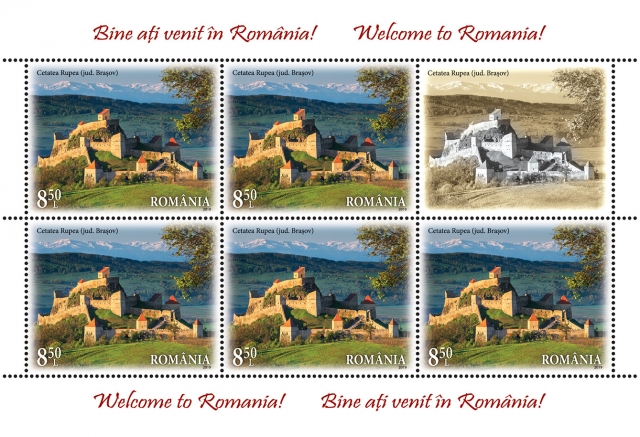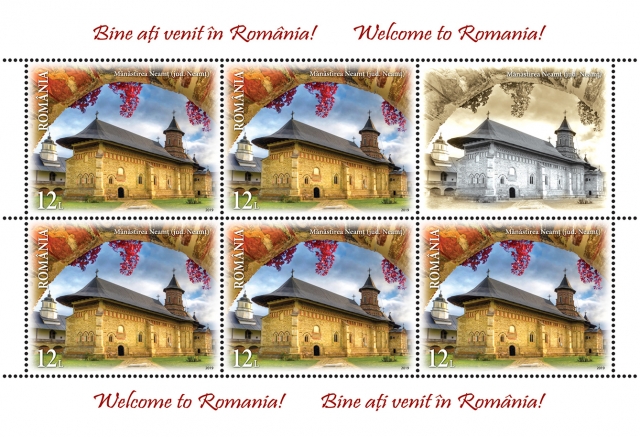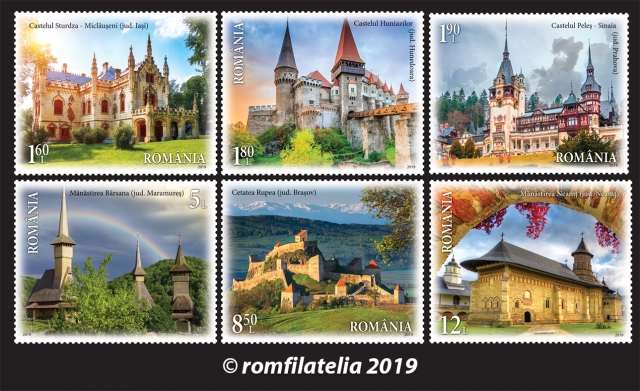Welcome to Romania! A traditional greeting addressed to guests eager to experience the natural, spiritual, historical and architectural beauties of Romania. Romfilatelia introduces into circulation a postage stamps issue with the title of the aforementioned wish, on Thursday, May 9th, current year, date coinciding with Europe Day, also celebrated in Romania, as a State of the European Union.
On the postage stamp with the face value of Lei 1.60 is illustrated the Sturdza Castle from Miclauseni, also known as the Sturdza Palace, built between 1880 and 1904 in the Gothic style by Gh. Sturdza and his wife Maria (born Ghica), on the site of an old manor house dating back to 1755. The exterior decorations of the castle feature details of the Sturdza family coat of arms, along with the emblem of the castellan George A. Sturdza, inspired by the icon of Saint George. The interior of the castle has ceilings and walls painted in tempera with floral and geometric patterns, under the coordination of the architect Julius Reinecke.
After many unfortunate happenings damaged its beauty, without fading away its inestimable value, it was restored in 2004.
On the postage stamp with the face value of Lei 1.80 is depicted the Hunyad Castle, one of the most important monuments of Gothic architecture and feudal art in Romania and in Europe, impressing with the various architectural styles and legends woven around it.
Stunning construction with towers and bastions, the castle was built by Iancu de Hunedoara in the 15th century, on the site of an old Roman camp. Hunyad Castle is one of the most beautiful and well-preserved buildings from the medieval times, being the most important real estate of Iancu de Hunedoara, the first attestation of the castle dating back to 1443.
The most significant parts of the construction have remained unchanged from an architectural point of view since the time of Iancu de Hunedoara, such as the Capistrano Tower (named after a famous Franciscan monk, John of Capistrano), the suspended gallery and the Neboisa Tower.
On the postage stamp with the face value of Lei 1.90 is illustrated the Peles Castle in Sinaia, rightly considered the “Crown Pearl” and one of the most beautiful castles in Romania.
From the very beginning it was meant to be a royal summer residence. In August 1875, at the ceremony of foundation stone laying of the castle, King Carol I said: “Let this castle safely rise and be completed, in order to become the cradle of my dynasty, of the national dynasty.” In the foundations wall was enclosed the deed of foundation and the deed of construction, along with several coins with the effigy of Carol I. The castle is located on the shore of the Peles brook.
In over 150 rooms of the Peles Castle we find different styles that harmoniously blend: the German, Italian and Gothic Renaissance, German, Austrian and Turkish Baroque, and French Rococo. With more than 4,000 pieces, the collection of parade and hunting weapons is one of the largest in Europe.
On the postage stamp with the face value of Lei 5 is illustrated the Barsana Monastery, located in the historical Maramures region, on the Iza River valley and built in 1711 on the site of an old monastery whose history began with the documentary attestation of Barsana village in 1326.
The unfavourable circumstances caused its translocation twice until 1795, when it was placed in the middle of a cemetery for plague victims. The indoor walls were repainted by Hodor Toader in the year 1806, the paintings being made on wood, the walls being flattened with textile pieces fixed to the walls and covered with lime, according to the custom of those times.
The monastic complex built under the coordination of the architect Cordos Dorel includes a gateway specific to the Maramures region, the bell tower, the 57-meter-high church, the summer altar, the multi-level chapel, the monks’ chambers, the house of the masters and the workshop of the artists.
UNESCO’s World Heritage List includes eight wooden churches built between the 14th and 18th centuries (Ieud-Deal, Poienile Izei, Budesti-Josani, Rogoz, Barsana, Surdesti, Desesti and Plopis).
On the postage stamp with the face value of Lei 8.50 is presented the Rupea Fortress, a representative historical monument of Brasov County, that has documentary attestation since the year 1324, being the refuge of the Transylvanian Saxons from the armies of King Charles I of Hungary.
The towers were built to ensure defence functions, and their historical development shows various architectural features.
The walls of the fortress have been preserved for the most part, but they are devoid of the decorations that must have been made of wood, as it can be seen at the Diecilor Tower.
On the postage stamp with the face value of Lei 12.00 the Neamt Monastery distinguishes, which is part of the national artistic and historical heritage, being called the “Jerusalem of the Romanian Orthodoxy” because it occupies a very special role in the Romanian religious culture through its magnificence and beauty.
The Neamt Monastery imposes itself as one of the most interesting and representative monuments of the 14th-15th century architecture, both from plan and the mastery of the decorations point of view.
The polychromic elements of the façade are enriched by enamelled brick stringcourses and pillars, surrounding the monument, along with the buttress specific to the Moldavian architecture.
The windows have been enlarged over the years, but since the restoration of 1958-1961, the original shape was brought back.
The religious establishment also preserves under its shelter the oldest monastery library, which totals 18,000 volumes of great importance for the medieval Romanian culture and art.
On the perforated souvenir sheet of the issue having the postage stamp with the face value of Lei 28.50 is illustrated the panoramic image of the urban area known as the Great Square, with the Sibiu City Hall building in the foreground, as an emblematic edifice for the city of Sibiu, venue of the Informal Summit of Heads of State or Government of the European Union, to be held on May 9th, 2019.
Romfilatelia thanks to the City Hall of SibiuRomanian Court of Accounts for the photographic support granted for the achievement of this postage stamps issue.
The postage stamp issue Welcome to Romania! will be available on Thursday, May 9th 2019, in Romfilatelia’s shops network in Bucharest, Bacau, Brasov, Cluj-Napoca, Iasi and Timisoara and online on https://romfilatelia.ro/store/. The postage stamp issue is completed by 2 “first day” covers, as page composition in sheet of 20 stamps, minisheet of 5 stamps + 1 label, block of 6 imperforated stamps and perforated souvenir.
For further information, please contact the Public Relation Office:
Tel: 021 / 337 24 42



